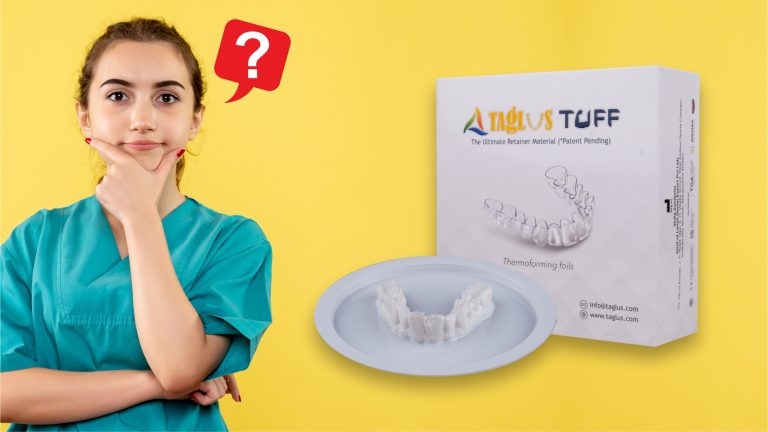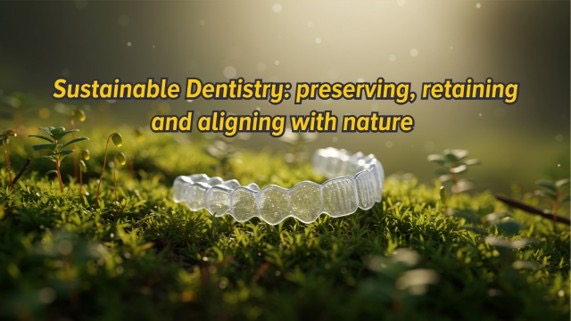Enquire Form
How Do You Select a Retainer Material?

When it comes to orthodontic treatment, retainers play a vital role in maintaining tooth alignment after treatment is completed. The material selection is essential to ensure the retainer’s effectiveness, durability, and comfort. Today, we will discuss the ideal properties of retainer materials and why Taglus Tuff represents the ultimate choice for dental professionals.
Importance of Retainer Material Selection
Clear plastic retainers, widely used today, are made using thermoforming sheets. To achieve optimal results, it’s important to use high-quality thermoforming sheets that possess the durability and effectiveness required for retainers. Understanding how to select standout materials is essential for any dental practice or lab.
Retainers are typically made from specific plastics chosen for their strength, flexibility, durability, and clarity. These materials include:
- Polyethylene Terephthalate Glycol (PET-G)
- Copolyester
- Polypropylene
- Polyurethane
Thermoplastic retainers tend to have shorter lifespans due to issues like cracking, discoloration, wear, and water absorption.1 One of the most common failure points of thermoforming retainers is fracture.2 Hence, it’s crucial to select a material that resists these challenges.
Ideal Properties of Thermoforming Retainer Material
Minimal Thickness
A good retainer material should have minimal thickness to prevent open bites. Thicker retainers can cause arch separation, leading to open bites.3
Flexural Modulus
A material’s flexural modulus determines how well it resists bending. A low modulus makes it easier to insert and remove, but may not provide enough retention. A higher modulus increases rigidity but can make it harder to wear. Ideally, a thermoplastic material should have a flexural modulus of at least 1500 MPa.1
Hardness
The material should have high hardness to resist penetration.1
Surface Roughness
Thermoplastic retainers should have low surface roughness to ensure comfort and longevity.1
Transparency
Transparency is essential to resist discoloration over time. A high-quality material should remain clear even after prolonged use in the oral environment.
Why Taglus Tuff is Your Ultimate Choice
Taglus Tuff is designed as one of the thinnest retainer materials, at just 0.8 mm, providing exceptional comfort without compromising strength. This innovative retainer combines minimal thickness with high performance, making it barely noticeable when worn while effectively maintaining teeth alignment.
Key Features of Taglus Tuff
- Unmatched Comfort: At just 0.8 mm thick, Taglus Tuff offers unparalleled comfort, making it easy to wear for extended periods.
- Exceptional Strength: With a break strength of 59 MPa, Taglus Tuff is built to last and resist breaking. Its 7% yield elongation allows for flexibility without losing its shape.
- Reliable Performance: The 41 MPa yield strength ensures it maintains the necessary force to keep teeth aligned after orthodontic treatment.
- Dual Protective Coating: Both sides of the retainer are coated to protect against scratches and moisture, extending its lifespan.
Taglus Tuff retainers are the perfect choice for maintaining a smile after orthodontic treatment due to their durability, comfort, and superior performance.
Conclusion
For long-term orthodontic success, selecting high-quality retainer materials is essential. A durable, flexible, clear, and biocompatible material ensures patient satisfaction and effective treatment. Taglus Tuff retains all these ideal properties, making it an exceptional choice for modern dental practices.
- Albilali AT, Baras BH, Aldosari MA. Evaluation of Mechanical Properties of Different Thermoplastic Orthodontic Retainer Materials after Thermoforming and Thermocycling. Polymers. 2023; 15(7):1610. https://doi.org/10.3390/polym15071610.
- Alassiry AM. Orthodontic Retainers: A Contemporary Overview. J Contemp Dent Pract 2019;20(7):857–862.
- Giancotti A, Mozzicato P, Mampieri G. Thermoformed Retainer: An Effective Option for Long-Term Stability. Markopoulos A, ed. Case Reports in Dentistry. 2020;2020:1-7. https://doi.org/10.1155/2020/8861653.
- Ayat M. Hussein, Harraa S. Mohammed-Salih, Iman I. Al-Sheakli. Effects of various cleaning agents on polypropylene and copolyester thermoplastic orthodontic retainer materials, Journal of Taibah University Medical Sciences. Volume 17, Issue 5, 2022. Pages 861-868. https://doi.org/10.1016/j.jtumed.2022.04.005.
Know More About Us
SignUp To Our Newsletter And Get To Know More About Taglus
Copyrights@taglus-2025
*Taglus is a trademark of Vedia Solutions










Leave a Reply